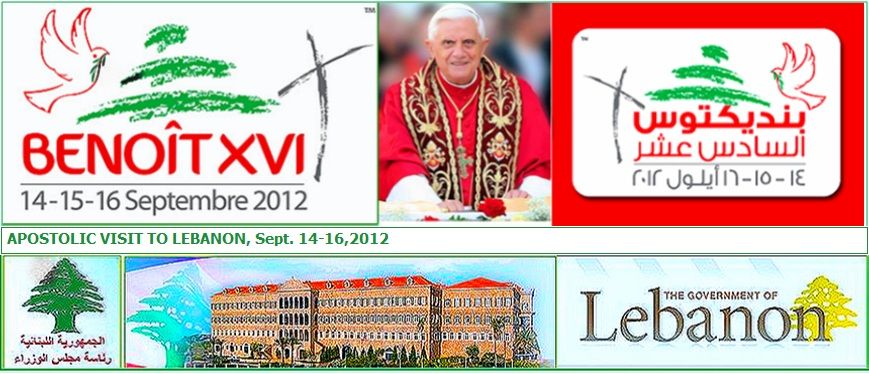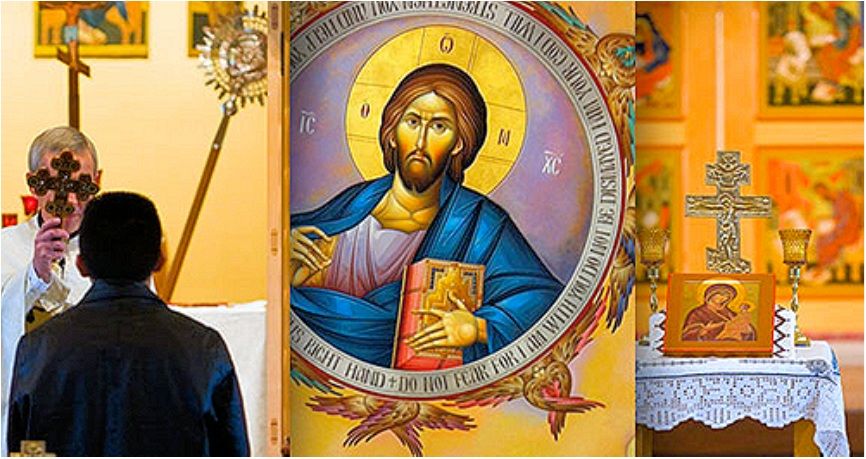 As Benedict XVI prepares to visit Lebanon, here is a useful introduction to 'Eastern' Christianity and their distinct non-Latin liturgies, about which most Catholics have very little awareness. The writer is a graduate student in Orthodox theology at the Franciscan University of Steubenville, Ohio.
The 'Eastern' Christians
As Benedict XVI prepares to visit Lebanon, here is a useful introduction to 'Eastern' Christianity and their distinct non-Latin liturgies, about which most Catholics have very little awareness. The writer is a graduate student in Orthodox theology at the Franciscan University of Steubenville, Ohio.
The 'Eastern' Christians
and their distinctive liturgy
by Christopher B. Warner

August 17, 2012
In an overwhelmingly Muslim Middle East, it is surprising to note that one-tenth of all Syrians are Christian, and even more shocking to discover that almost half of the population of Lebanon is also Christian. It is a wonder there are any Christians left in that part of the world at all.
But then, these are no ordinary Christians. Most Christians in the Middle East are not Roman Catholic or Protestant—they are Eastern Christians with a unique heritage distinct from Western forms of worship and practice. Perhaps their millennium-old customs make them robust enough to stay in countries where they are surrounded by hostile neighbors.
“It is their faith,” says George Baho, a native of Damascus, Syria. George told Catholic World Report, “Without a strong faith, Christians in Syria could not persevere under a Muslim majority.”
His parents moved to Damascus from a small village in northern Syria called Mardeen. Mardeen is one of many small, isolated, Christian villages in the Middle East that heroically cling to their Christian culture and identity. The Baho family is Syriac Catholic—one of many Eastern Christian communities in the Middle East. Syriac Catholics have their own distinct monasteries, churches, liturgy, and hierarchy within the Catholic Church.
Lebanon is actually governed by the Christian majority of that state, the Maronite Catholics. But Syria and Lebanon are home to half a dozen other Eastern Christian communities as well, including Greek, Armenian, Syriac, Assyrian/Chaldean, and Coptic Christians. These communities celebrate liturgies that developed independently of one another more than a thousand years ago. They have preserved a cultural treasury of liturgical beauty and depth that is waiting to be explored by Western Catholics.
Blessed John Paul II called for the Church to breathe with “both lungs,” incorporating the rich traditions of both the East and West. In 2011, Pope Benedict’s general intention for the month of November was “that the Eastern Catholic Churches and their venerable traditions may be known and esteemed as a spiritual treasure for the whole Church.” Most Roman Catholics, however, have yet to discover how this can be practically achieved.

The most obvious difference between East and West is the liturgy. The prayers and actions of the Mass are not the same in the Christian East. The Catholic East practices five distinct rites, or liturgical traditions, that mirror the Eastern Orthodox and Oriental Orthodox churches (which are not in union with Rome). To understand the difference in liturgy, it is necessary to look back to the regrettable schisms in the Church.
During the fifth and sixth centuries, the Alexandrian and East Syrian bishops broke away from the Greek and Latin Church, marking the first schism in the Christian Church. These Churches are called the “Oriental Orthodox” (Iraqi Assyrians, Egyptian Copts, etc.)
The early part of the second millennium witnessed another significant rupture between the Latin Church of the West and the Greek Church of the East — the gradual, tragic result of linguistic, liturgical, disciplinary, theological, and cultural differences. The Eastern Church took the title “Orthodox,” and the West, “Catholic.”
Over time, many Eastern Orthodox Christians resumed communion with the bishop of Rome, and are called Eastern Catholics. These Churches are known as the Alexandrian (Egypt), the East Syriac (Iraq/Iran/India), the West Syriac (Syria/Lebanon/India), the Armenian (Armenia), and—the largest—the Byzantine (Greece, Russia, and the Slavs) Churches.
Most Roman Catholics who are familiar with the East have knowledge of the Byzantine tradition. The Byzantine Catholic Church is made up of 13 “autonomous ritual Churches,” such as the Ukrainian, Ruthenian, Melkite, and Romanian Catholic churches. These Churches have parishes worldwide and are governed by their own hierarchy of bishops who are in full communion with the Pope.
When asked, “Why are you Byzantine Catholic?” Shelepets Baumann, a parishioner of Sts. Cyril and Methodius Byzantine (Ruthenian) Catholic Church in Fort Pierce, Florida, replied: "I was born into the Byzantine faith and practiced it all of my life. Like most things [I began] to take it for granted. However, I never realized until my adult years how precious the Byzantine Catholic faith is and how beautiful the Divine Liturgy is. As an ex-flight attendant and presently a traveling nurse, my jobs have taken me to many parts of the states and I have not always had the opportunity to go to a Byzantine Catholic church, so I [often attend] the Roman Catholic church…[but] when I go to my Byzantine Catholic church, I am home."
Blessed John Paul II, in his effort to bring together the East and West, issued two distinct challenges. Because Eastern Catholics are a minority, they must faithfully preserve their tradition and not be tempted to “Latinize” their practices. Roman Catholics, on the other hand, should seek out some amount of liturgical and intellectual exposure to the Christian East for spiritual and cultural enrichment.
As John Paul the Great knew, in the current war against secularism, both lungs are necessary in order to provide enough “oxygen” for the spiritual battle raging in today’s world. The Eastern perspective expands the arsenal of the Western Church’s theology and prayer life. So, on the one hand, breathing with both lungs reinforces the Church Militant, but it is also an invitation to broaden one’s horizon through a beautiful encounter with Christ, who is new every morning.
The Eastern lung could analogously be called the feminine branch of the Catholic Church. This does not mean saccharine, feel-good Christianity, but rather that the East is notably mystical and contemplative. The Eastern Church provides a nurturing, liturgical environment for its members to encounter the Most Holy Trinity.
The East complements the Western need to act upon the world with missionary zeal by being more singularly focused on the liturgical and interior spiritual life of Christianity than its Roman counterpart.
Christians, East and the West, are all called to holiness and believe the same truths, but the Eastern “feminine” view is different than the analogous masculine perspective. The Eastern Church offers a different vocabulary, a unique lens on the Catholic faith through a liturgical encounter with God.
“There’s not just one way to be Catholic,” says Father Thomas Loya, radio host of “Light of the East” and pastor of Annunciation Byzantine Catholic Church in Homer Glenn, Illinois. The different cultural and liturgical practice of Catholics around the world “is what makes the Church truly Catholic.”
Father Loya emphasizes the complementarity of the traditions: “You can take the same faith and express it in a variety of ways. This creates unity in diversity.”
The Divine Liturgy (Mass) is the heart of Eastern Christian theology, mysticism, and culture. The old axiom is, “If you want to know what the Eastern Christians believe, attend the liturgy.”
One of the first things Roman Catholics will notice about the liturgy is that there is no quiet meditation. There are no pauses — the chanting never ceases. Yet, the Byzantine liturgy is an active meditation with a very rich vocabulary of prayer. Eastern Christian theology is at the service of prayer, because the entire aim of that theology is to find words fitting for prayer.
Eastern liturgy exhibits an enticing beauty and grace: the smell of incense, the unbroken chant, the striking icons. The senses are transfixed throughout the liturgy, which gives the feeling of timelessness and ascension into glory.
Baumann of Fort Pierce, Florida further notes: "Our Divine Liturgy is so beautiful that certain parts of it always bring tears to my eyes because of its beauty. There is reverence in our church for God. People respond with enthusiasm and one can feel that you are in a holy place, in the presence of the Father, Son, and Holy Spirit…. Our other worship services are filled with words of such beauty that are offered to God…not to mention our beautiful music…"
This modern-day Byzantine Catholic parishioner is not the first to be awed by the beauty of the Eastern services. A famous 10th-century Russian, after experiencing the Greek Divine Liturgy for the first time, exclaimed, “We no longer knew whether we were in heaven or on earth…such beauty, and we know not how to tell of it!” According to legend, the relation of this experience sparked the conversion to Christianity of the entire Russian people.
Roman Catholics often feel like hobbits among Tolkien’s high elves or travelers in an exotic country upon their first encounter with this liturgy. The East speaks a different language. And, as John Paul II fittingly stated in his letter Orientale Lumen: “The words of the West need the words of the East, so that God's word may ever more clearly reveal its unfathomable riches.”
[Modificato da TERESA BENEDETTA 19/08/2012 20:16]